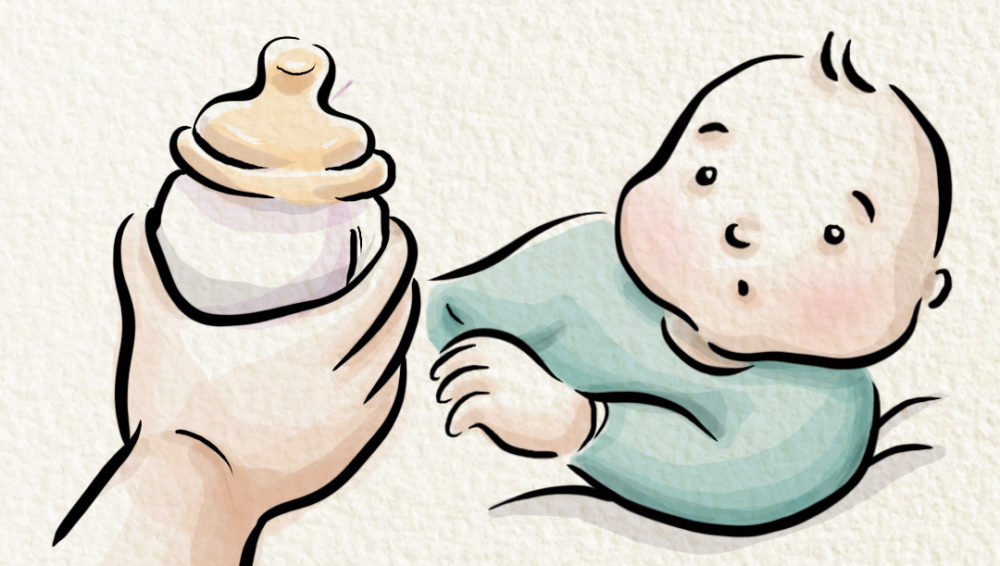Month 5: Understanding sleep routines

As their alert time becomes longer, Your Child will enjoy spending time playing with the surroundings, and you may start thinking about establishing sleep routines.
How are you and your baby
After discovering their hands, your baby will be grabbing everything within reach, and they may try to reach for their toes when lying down on their back. The ability to grab is a big development; It shows that they are becoming self-aware and learning about their body parts, and specifically, they are developing hand-eye coordination.
In terms of play and social skills, Your Child is now less easily startled by big sounds, may enjoy musical toys, and may like different motion activities, such as swinging, rocking, bouncing, or even dancing.
As your baby spends less time sleeping and more time practicing crucial life skills, it may be harder to spot cues like hunger or tiredness. You may want to observe your child’s changing behaviors more closely to understand changes in their sleep cycles so you can adjust their routines accordingly.
What is a baby’s sleep cycle
A sleep cycle consists of two main stages of sleep called Non-REM sleep and REM sleep. A cycle starts when the baby falls asleep, enters Non-REM sleep, which consists of light and deep sleep, and then moves on to deep REM sleep where dreams can happen. A typical cycle for an adult is 90 minutes, while babies as young as 5 months old have 50-60 minutes.
Typically, young babies may move around and grunt during the early stage of Non-REM sleep, but once they settle into the deep sleep stage, they become still. During any periods of REM sleep or when transitioning from one cycle to the next, they may awaken. Babies spend 50% of their sleep in the REM cycle, whereas adults spend only 20% — this is why Your Child may wake up more often during expected long night sleep.
Generally, babies this age require about 15 hours of sleep a day in total, with night sleep of about 10-12 hours and 2 or 3 naps during the day.
Sleep is vital to Your Child’s healthy developments. During each stage of sleep, the body and brain go through necessary repairs and growth. At this age when Your Child’s urge to explore is so strong that they hardly settle down, it is necessary to have predictable routines to help your little one get adequate sleep.
How to establish sleep routines
Healthy sleep associations: Sleep associations refer to common factors that a baby depends on to fall asleep, such as sucking on breast or rocking. To establish healthy sleep habits, you can help your baby fall back to sleep — if awakened during the transition to the next cycle — by creating independent associations of night sleep, such as a dark environment and a boring but peaceful atmosphere before going to bed. So, when the baby wakes up, they see the same environment they fell asleep in and do not get scared.
Predictable bedtime routines: For children whose temperament makes it more challenging to settle down to sleep, having a bedtime routine can help. Knowing what to expect — finishing activities in the same order before sleep every day — helps prepare a calmer mental state.
Co-sleeping: If your child is not ready to be away from you, co-sleeping can be a great way to help your baby fall asleep without physically helping them. Knowing that you are there next to them gives them the security to fall back to sleep.
Why you should understand your child’s sleep cycles
Many new parents struggle to understand their baby’s sleep patterns, as these sleep patterns vary greatly and change over time. For example, some babies may not sleep without interruption at night for 5 hours, but some may sleep for more than 10 hours straight. Also, some babies may not have a mature sleep cycle (sleeping through the night) until 2 years old.
Moreover, as your baby gets older, the duration of their day naps may get shorter and combine into a longer nap, eventually reaching about 1 nap at around 3 years old. Out of sync day naps or unusual wake-up times can temporarily happen during this transition and can create confusion for new parents.
As your baby approaches the 6-month mark, Your Child will be going through many big changes like separation anxiety, which can also disrupt Your Child’s sleep patterns.
So, many new parents, especially sleep-deprived or depressed parents, may be tempted to try the so-called sleep training, which involves letting the baby cry until they sleep at night in an attempt to make their baby sleep longer. However, letting children cry for prolonged periods creates toxic stress, which may interfere with the necessary growth and repair mechanisms during sleep. Moreover, children only learn self-soothing and necessary emotional regulation skills from you when you are attentive to their needs, and not from neglect.
Lastly, environmental factors such as light and sound and genetic factors can play a role in a baby’s ability to settle to sleep and the length of sleep. This is why it may make sense to observe Your Child closely and respond to their unique needs, instead of benchmarking their expected sleep cycle to those of other children and stressing everyone involved.
Verified:
Ketsupa Jirakarn (Mental health specialist) (18 February 2022)



